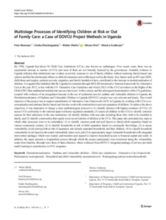Abstract
By 1996, Uganda had about 36 Child Care Institutions (CCIs), also known as orphanages. Over recent years, there was an exponential increase in number of CCIs and most of them are not formally licensed by the government. Available evidence in Uganda indicates that institutional care is taken as priority response to out of family children without exploring family-based care options and this has detrimental effects on child development and wellbeing as well as the future. Key factors such as HIV and AIDS, child abuse and neglect, endemic poverty, migration, and family breakdown have contributed to the increase in institutionalization of children. It is against this backdrop that the Uganda Government through MGLSD introduced a National Framework for Alternative Care in the year 2012, in line with the UN Alternative Care Guidelines and Article 20(3) of the UN Convention on the Rights of the Child (CRC) that emphasized institutional care as a last resort. In this context, and the subsequent domestication of the UN guidelines, coupled with evidence of an unregulated increase in the use of residential care for orphans and vulnerable children in Uganda, the Deinstitutionalization of Orphans and Vulnerable Children in Uganda (DOVCU) project was very relevant and timely. The overall objective of the project was to support actualization of Alternative Care Framework (ACF) in Uganda, by working with CCIs to re-conceptualize and embrace family-based care but also work with communities to prevent separation of children. To achieve the above objectives, it was imperative to design a clear methodological protocol to (1) identify districts with highest numbers of CCIs, (2) assess CCIs conformity to the national approved home regulation standards, (3) assess all children in the CCIs to identify common reasons for their admission in the care institutions, (4) identify children with case plan including those who wish to be reunified in family, and (5) identify communities that supply most record number of children to the CCIs. This paper also articulates key steps in which other processes were to be undertaken: (1) to identify common push and pull factors to family-child separation based on various community context, (2) to identify households at risk of child separation based on community knowledge, (3) to assess vulnerability levels among both at risk of separation and already separated households and their children, (4) to classify household vulnerability levels based on the tested vulnerability index tools, and (5) to appropriately target vulnerable households with integrated intervention packages which were mainly cash transfers and support to improve household access to financial capital and credit. In addition, the paper presents a longitudinal process through which the project participants were monitored along the vulnerability scales from baseline, through wave three of data collection, where evidences from DOVCU integrated package of services provided useful learning to practitioners in OVC programs.

